|
Home
About This Site
Air Cleaners
Audio
Carburetors
Charging System
Chassis
Cooling System
Decoding
Detailing Center
Diecast Cars
Differential
Documentation
Driveshaft
Engine Bay Detail
Engine Brackets
Engine - External
Engine - Internal
Engine Tags
Exhaust
Exterior
Favorite Links
Fuel System
Gallery 1
Gallery 2
Gallery 3
Gallery 4
Gallery 5
Gallery 6
Gallery 7
Gallery 8
Gallery 9
Gallery 10
Gallery 11
Gallery 12
Gallery 14
Gallery 15
Gallery 16
Gallery - Photos from For Sale Ads
Heater & A/C
Ignition
Interior
Junkyard Cars
Memorabilia
Mustang Monthly Article Index
Oil Cooler
Paint Info
Parts Sources
Performance Data
Photography
Pulleys/Belts
Registry 71 429 Cougar
Registry 71 429 Mustang
Smog/Emissions
Special Topic
Special Topics 2
Starting System
Statistics
Steering
Suspension
Tech Writeup Index
Transmission
T-Shirts
Trunk
Underhood Component Coatings
Videos
Vintage Ads
Under Hood Non Engine Components
Wheels/Tires
Index
| |
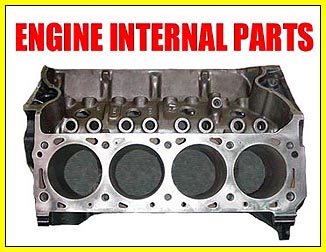
This page shows details of
the 429 CJ/SCJ Heads, Block, internal components and some specialty 429 parts.
(Note: Click thumbnails to enlarge pictures.)
|
429 CJ/SCJ Cylinder Head and Components
See this link for Dan Davis's writeup: Valve
Lash Made Easy |

The 429 CJ/SCJ head was Part #D0OE-6090-R. This
photo shows a view of the combustion chambers. |

Top
Side |

Intake
Side |
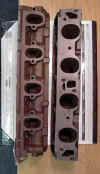
Port Comparison |
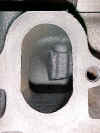
Exhaust Port Closeup |
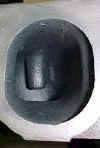
Intake Port Close |

Combustion Chamber |

Spring Seat Area |

Exhaust/Intake Valve comparison |

1.73" Exhaust |

2.24"
Intake |
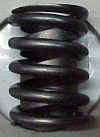
Valve
Spring |
| Rocker Arms
The early (until start of calendar year 1970) CJ's used an adjustable
valvetrain like the SCJs. These engines used a prevailing-torque nut (aka
"lock" nut).
The later CJs used a bottleneck stud that was tightened to a specific torque
-- i.e., no adjustment. There were no jamb nuts used on a factory install
for either CJ or SCJ. |

Head Part
# |

Head Part #
Location |

Date
Code |
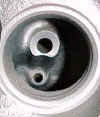
Exhaust Bowl
|
|
For more information on 429
Cylinder Heads, click the link to this site:
429/460
Cylinder Head Casting #'s /Application Information /Brief Descriptions |
|
429 CJ/SCJ Blocks
The Four Types of 429s
(Thanks to Dan Davis)
First was the base 429, known as the
Thunder Jet (TJ). It came in T-birds and full size Fords in the late 60's
and early 70's. Typically 360 horsepower. By far and away the most common
-- they made 100,000+ of these. Can be ID'd be block casting numbers of
C8SE, C9VE, D0VE, D1VE among others and head casting numbers of C8SE,
C9VE, D0VE among others.
Then there was the 429 Cobra Jet (CJ). It was built only in 1970-71. It
was only installed in mid-size (1970-71) and pony cars (1971 only). 370 HP
(likely underrated), thick strong blocks and massive ports int he heads.
ID'd by D0VE-A and D1VE-AA casting numbers on the block and D0OE-R on the
heads. No other numbers are CJ. Not too common, maybe a total production
of 15,000.
The 429 SCJ was a stronger version on the CJ. The difference was forged
pistons, solid lifter cam and four bolt mains*. The rest of the info is the
same. Even less common with a production of maybe 3,000.
The baddest of them all is the Boss 429. It was rated at 375HP (grossly
underrated). It came in special Mustangs (and 2 Cougars) in 1969-70. It
had four bolt mains, aluminum hemi-style heads and looked like no other
engine. ID by casting number on the block of C9AE. The heads ID
themselves. Very rare and very expensive as only about 1,200 were made.
(* Correct for 429 SCJ Torino. On 71 429 SCJ
Mustang, both 2 and 4 bolt mains were possible - JB) |
|
429 CJ/SCJ Blocks |
|
D0VE-A 4 Bolt Main Block |
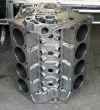 |
 |
 |
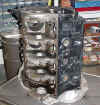
|
 |
| D1VE-6015-AA 4 Bolt Main Block |
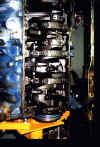 |
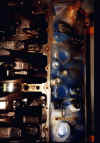 |
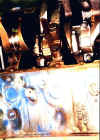 |
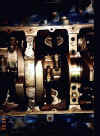
|
 |
|
About Block Part Numbers |
|




CJ/SCJ Blocks
Correct 429 CJ/SCJ Block Casting Numbers
The red arrow above left indicates the location of
the 429 CJ/SCJ engine block casting number. A closeup is shown at center
of the D0VE-A and the D1VE-6015-AA at right. The 429 CJ/SCJ engines used in
the 71 Mustang/Cougar had either a D0VE-A or a D1VE-6015-AA block.
But here's a special note about the D1VE
block part numbers - CJ/SCJ D1VE blocks have the "D1VE-6015-AA"
casting number while base blocks have only a "D1VE-AA" casting number
without the -6015- in the middle. This appears to be a screw-up by the
factory! D1VE-6015-AA is supposed be a CJ block (since we have
seen more as CJ than non-CJ), but due to the info we have uncovered
(click this thumbnail photo:
 ),
its best to verify first if the block is a thin or thick web before
deciding if it is a CJ. See the two photos below for
examples of this;
),
its best to verify first if the block is a thin or thick web before
deciding if it is a CJ. See the two photos below for
examples of this;


429 CJ/SCJ Main Bearing Webs In addition
to the casting numbers, CJ/SCJ
blocks were signified by having thicker main bearing webs
than the standard 429 blocks. Note
in the photo below how the webs on the CJ/SCJ block (left) get thicker,
stepping from 1” to 1.4” near the intersection of the web to the
sidewall while the base 429 block webs are noticeably narrower;

Also note that the CJ/SCJ webs are taller
and machined to the same height as the oil pan rail.
By contrast, main bearing webs on the base 429 (Thunder Jet)
block at right get thinner as they meet the sidewall and are not as tall
as their CJ/SCJ counterparts. Instead
they are as cast and end below the oil pan rail.
Two -vs- Four Bolt Mains
Since the two or four bolt caps were
added after the block was cast, the casting number WILL NOT tell you if
it is a two or four bolt main block. What it WILL tell you is that the
block has thick main webs, making it a CJ/SCJ block (PI too).
(Thanks to Dan Davis for this info and
photos)
|
|
Pistons |

Pistons
The cast 429 Cobra Jet pistons were marked with the
"429 CJ" as shown above. The 429 SCJ used forged pistons from
TRW and were marked with the TRW #L2366F stamped on the top surface. |
|
Rods
|
|
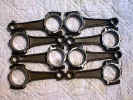
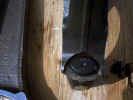
Rods
These are 429 CJ rods. The photo at right shows
the special type of machining around the bolt head done to the DOOE (CJ)
rods, which helped make them a little stronger.
|
| Intake
Manifolds |


The photo above shows the CJ Intake with the Rochestor
Carburetor spreadbore pattern. The photo at right is the underside. The
part number is D0OE-9425-D. |

This is the SCJ Intake with the Holley Carburetor pattern.
Part number D0OE-9425-C |

Intake Mamifold Gaskets
Note that there is a big difference between the CJ and
standard 429/460 Intake gaskets. A problem to watch out for is when you call
the parts store (and even specify it must be a CJ gasket) they still often
send the standard 429/460. Group member Allan Shepley has talked to two
different people recently that have installed the wrong gaskets and the
engine still ran but there was a vacuum leak. Be sure to check your gaskets
with your intake port dimensions before installing! Note that in photo above,
the standard gasket is shown on top and the CJ version on the bottom.
|
| Timing
Chain/Cover/Lifter Valley
|
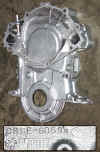
The Timing
Cover and part number.
|

Installed view of Timing Chain.
|

Top View of engine showing heads installed and lifter
valley.
|
|
Oil Pan/Pump
|
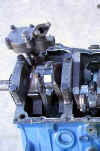

 
 Oil Pan/Pump
Pickup
Check out this link for our study
on oil pan depths:
Oil Pan Depth Survey The CJ/SCJ used a special pump. It was called the
"dual entry pump". Where the oil entered the pump's gear, there
where actually two entrances to the gear. The 429 CJ/SCJ pick up is
also shown above. Be cautious when installing aftermarket oil pumps/new pick up
tubes or sumps on your 429 CJ/SCJ engine. Some have been found to be too
long and touched the bottom of the pan, resulting in blockage of oil flow
and possible engine failure! If you install a new pump and pick up check
it out first. Also, be aware that the CJ pump and CJ pickup were longer
than the stock 429 part and should only be used with a CJ pan.
The CJ/SCJ oil pan photo at top right shows the configuration of the special baffle used.
The photo below details the oil flow path within the pump.
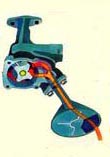
|
| Special Engine Components |


"SHELBY" Aluminum Manifold This is
a rare aluminum intake manifold available as an aftermarket part in the
70's for the 429 CJ/SCJ engine. It seems like these are turning up on
E-Bay every so often and we have had a number of questions about whether
this manifold will fit on a 429 Mustang. Since it is about 1" taller,
it will not clear the hood of a 71 429 Mustang with the factory ram air
air cleaner installed. However, Robert Myhrer has researched this matter
and has found a solution. Please click this link to see his special
write-up on this topic: How
To Make an Aluminum Shelby/Blue Thunder Intake Manifold Fit on a 71 429
Mustang with a Factory Ram Air Air Cleaner |



Police Interceptor Intake Manifold?
This is a strange version of the CJ intake manifold. The MPC lists this
D1AE-BA manifold as the intake for the 71 429 CJ. Note it's spaced for a Ford
carburetor, not the Rochester (which is what it should be if it were for a 429
CJ)! Maybe you were supposed to do some grinding to get the Rochester to
fit? It is believed that this is the intake that the 72 P/I (Police Interceptor)
engine used since the 72 P/I did use a Ford carburetor. |


429 Dual Quad aluminum intake


 |


429 Tripower Setup |

These 429 valve covers are aftermarket parts, but are
an interesting detail piece for those not wanting to use the factory
aluminum valve covers. |
| Police Interceptor Parts |
|

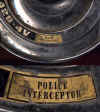

Since Police Interceptor parts are often confused with the 429
CJ/SCJ,
photos of 429 PI components will be shown above for reference. The D2OE 1972 PI
Exhaust manifolds are shown above right. For additional
information on Police Interceptor Heads, try this link: Police
Interceptor Heads |
Mike Troell's
429 CJ Mach 1 at the Concours D'Elegance in Canada
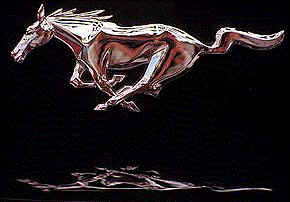
|
![]()
![]()